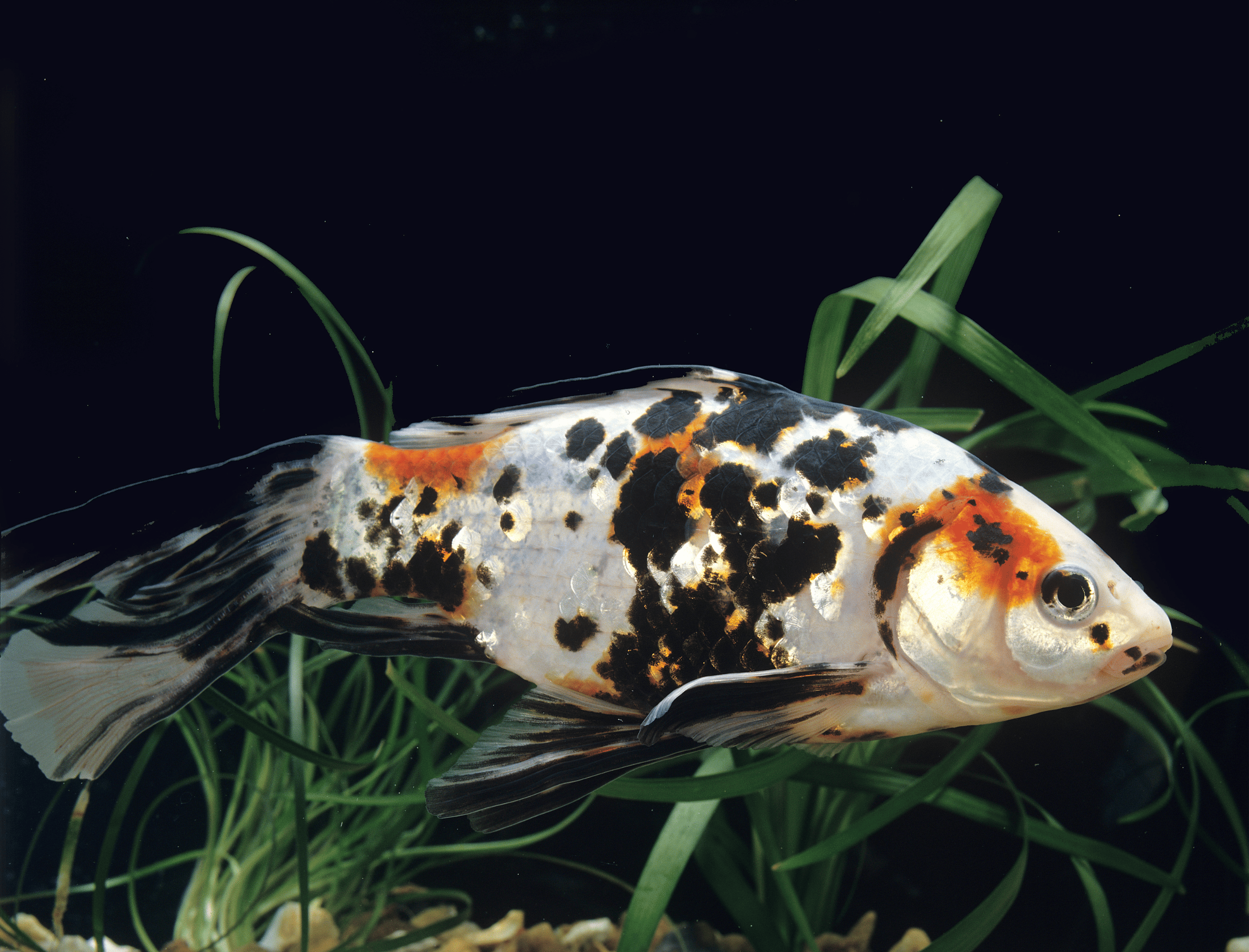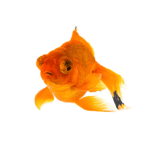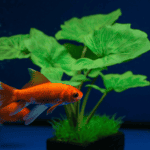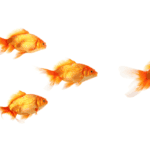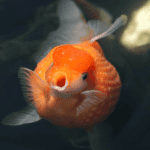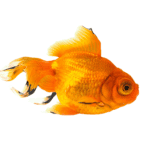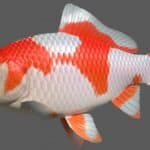Shubunkin goldfish, known for their striking calico patterns and nacreous scales, are a popular and hardy variety of single-tailed goldfish. Originating from Japan, the breed was developed by Yoshigoro Akiyama through crossing Calico telescope eye, Comet goldfish, and Common goldfish. The distinct appearance and lively nature of Shubunkins have made them a favorite among fish enthusiasts for both aquariums and ponds.
Growing in size based on their environment, Shubunkins typically reach around five to six inches in a standard aquarium setting. However, when provided with a larger pond-like space, they can grow up to 12 to 14 inches. Bearing this in mind, it is essential to provide a suitable habitat for Shubunkin goldfish to ensure their health and well-being. A minimum of 75 gallons is recommended for one or a pair of Shubunkins, with an additional 10 gallons per added fish.
As members of the Cyprinidae family, Shubunkins share characteristics with other goldfish species but are uniquely distinguished by their colorful calico patterning. Although they are artificial breeds not found in the wild, their ancestor, the Crucian carp, can be traced back to their natural origins. With proper care and a suitable environment, these beautiful and vibrant fish can make a great addition to any fish enthusiast’s collection.
History and Origin of Shubunkin Goldfish
Shubunkin Goldfish are an elegant and vibrant variety of goldfish that originated in Japan. They are known for their stunning calico patterns and long, flowing fins. These beautiful creatures are a result of various cross-breeding efforts in Japan.
In the late 1800s, Japanese breeder Yoshigoro Akiyama is credited for creating the Shubunkin by crossing the Calico telescope eye goldfish with the Comet goldfish and the Common goldfish. Through generations of crossbreeding, Shubunkin goldfish were developed into the captivating and hardy fish we know today.
Belonging to the Cyprinidae family, Shubunkin goldfish have the scientific name Carassius auratus auratus. Apart from the name “Shubunkin,” they are also known by other common names such as Calico goldfish and Harlequin goldfish.
Shubunkin goldfish are not found in the wild since they were the result of human manipulation and breeding efforts. They are descendants of the Prussian carp and are distant relatives of the Common and Comet goldfish varieties.
While there are currently 33 different types of goldfish, the Shubunkin goldfish stands out due to its unique coloration and graceful appearance. These fish have a lifespan of 10 to 15 years with proper care, and can even live for more than two decades in well-maintained environments.
In summary, the Shubunkin goldfish is a product of Japan’s rich aquatic breeding history that combines the beauty and elegance of calico patterns with the hardiness of Carassius auratus, resulting in a truly mesmerizing fish.
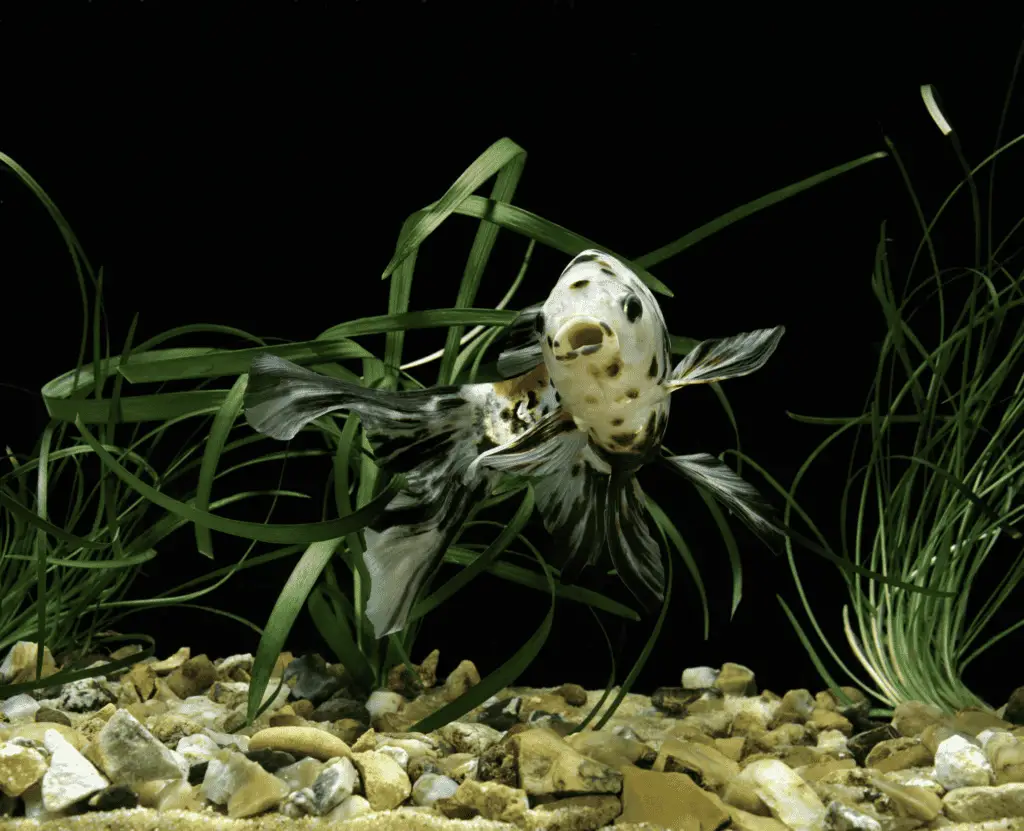
Types of Shubunkin Goldfish
Shubunkin Goldfish are a breed of long-bodied, fancy goldfish that originated in Japan. They have a distinct calico coloration superimposed on a blue background. There are three main types of Shubunkin Goldfish: Bristol Shubunkin, London Shubunkin, and American Shubunkin. Each type has its own unique features and characteristics, which distinguish them from one another.
Bristol Shubunkin
The Bristol Shubunkin is known for its elegant, flowing fins, and round tail. While they still possess the same calico coloration as other Shubunkins, they have a more symmetrical and balanced appearance.
London Shubunkin
London Shubunkins have a more slender body compared to the other types. Their fins are noticeably more rounded, giving them a distinct appearance. Although they share the same coloration as the Bristol and American Shubunkins, their body shape sets them apart.
American Shubunkin
American Shubunkins are thought to be the result of crossbreeding the Japanese Shubunkin with other goldfish species. They have a more streamlined, comet-like body shape, and their fins are not as pronounced as the Bristol or London Shubunkins. Despite these differences, they still display the beautiful calico pattern associated with all Shubunkin Goldfish.
In summary, Shubunkin Goldfish come in three main types: Bristol, London, and American. Each type boasts unique characteristics that make them stand out, but they all share the stunning calico coloration superimposed on a blue background.
Appearance and Colors
Shubunkin Goldfish are known for their unique and vibrant appearance. This variety of goldfish showcases a beautiful calico coloration, which sets them apart from other goldfish breeds. The term “calico” refers to the combination of various colors, including blue, red, white, orange, and black, often displayed as speckled or patched patterns on the fish’s scales.
The blue hue is especially notable and rare among goldfish, and it plays a significant role in defining the breed’s standards. In fact, the blue coloration is highly sought after by goldfish enthusiasts. This blue pigment is created by the fish’s black body color underneath their translucent scales, giving the scales an iridescent, metallic quality.
Shubunkin Goldfish are often heavily spotted, contributing to their unique appearance. No two Shubunkins have the same color pattern, making each fish a one-of-a-kind artwork in itself.
There are three types of Shubunkin Goldfish:
- American Shubunkin: These fish have a slimmer body, a straight caudal fin, and a forked tail. Their color patterns can be quite diverse, ranging from white to grey, with the speckled blue markings being the most special feature.
- Bristol Shubunkin: Known for their large, rounded caudal fin, Bristol Shubunkins boast a more even distribution of calico colors, often favoring blues and reds.
- London Shubunkin: These fish have a shorter, rounder body and shorter tail, though still displaying a distinct and attractive calico coloration.
In conclusion, Shubunkin Goldfish truly stand out among goldfish varieties due to their captivating calico coloration and the rare blue hue present in their metallic scales. With their breed standards focusing on these distinct color features, along with their unique spotted appearances, Shubunkin Goldfish are an exceptional choice for both novice and experienced fishkeepers.
Size, Lifespan, and Growth
Shubunkin Goldfish are a popular and hardy breed of goldfish known for their unique, colorful appearance. They can grow quite large with proper care and a suitable environment.
In terms of size, adult Shubunkin Goldfish typically reach lengths of 9 to 18 inches (23 to 46 cm). It is important to note that these fish can grow rapidly, so providing them with ample space in their habitat is essential for their overall wellbeing.
Regarding lifespan, Shubunkin Goldfish have a relatively lengthy life expectancy in comparison to other goldfish varieties. On average, they can live for 10 to 15 years if cared for properly with the right water conditions and diet. In some instances, these fish have been known to live for over two decades in a well-maintained environment.
Shubunkins are considered adults when they reach 1 to 2 years of age. During their growth period, it is crucial to provide them with a nutritious diet and clean water. They are also known to produce large amounts of waste, which makes maintaining optimal water quality even more vital.
Considering tank size, a single Shubunkin Goldfish requires a minimum of 30 gallons (113 liters) to thrive. As they grow, their space requirements will increase. For two Shubunkin Goldfish, a 55-gallon tank (208 liters) is recommended, and for a larger group, a 75-gallon tank (284 liters) or larger is necessary.
In summary, Shubunkin Goldfish have distinct size, growth, and lifespan characteristics that require attentive care, proper diet, and an adequate living environment. By meeting these needs, hobbyists can ensure their fish live a long and healthy life.
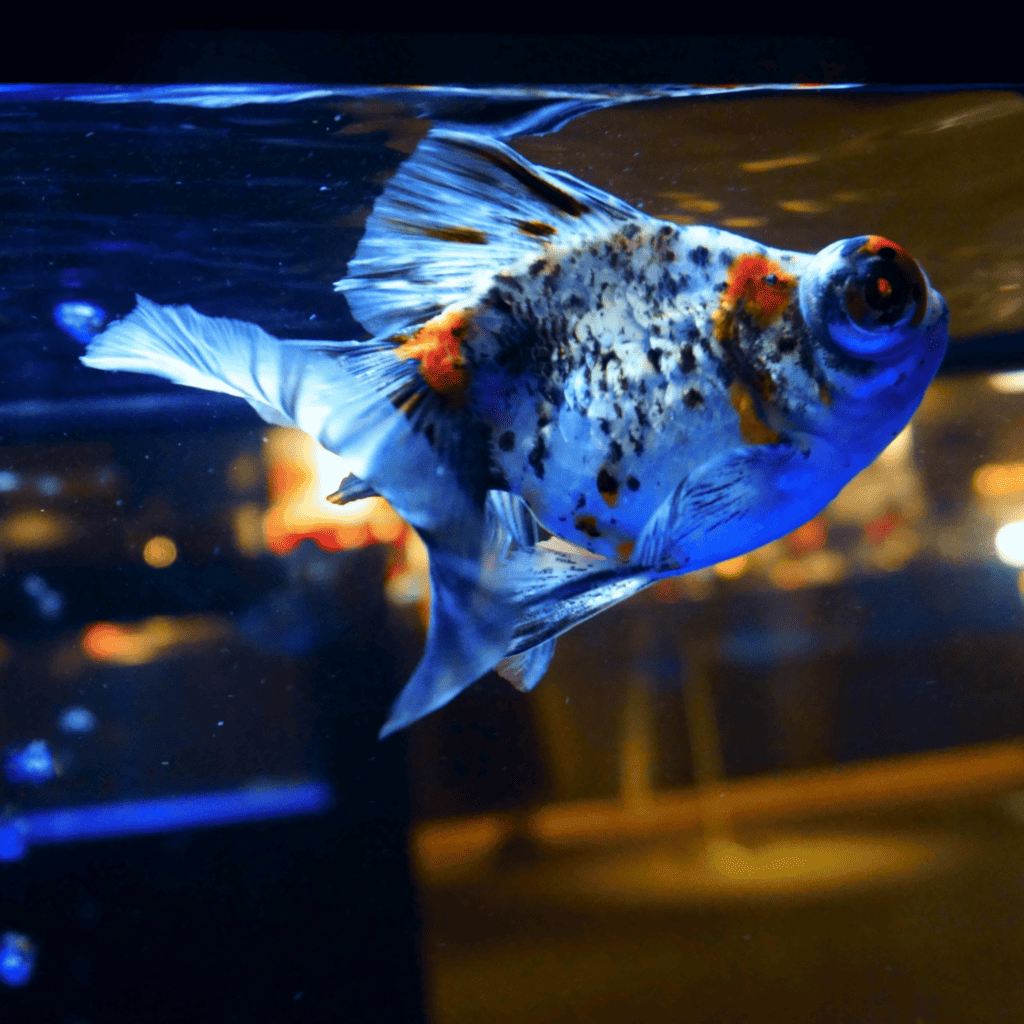
Shubunkin Goldfish Habitat
Shubunkin Goldfish, known for their unique calico coloration, are adaptable fish that can thrive in various habitats such as aquariums and outdoor ponds. They originate from Japan and belong to the Cyprinidae family of fishes.
Aquarium Setup
When setting up an aquarium for Shubunkin Goldfish, it is essential to consider their size and growth rate. A 75-gallon tank is recommended for adult fish, as they are fast growers and require ample space to swim around comfortably. The tank should also have:
- Proper water filtration to maintain water quality
- A heater to keep the temperature between 65-75°F (18-24°C)
- A gentle water current for better oxygen circulation
- Substrate, ornaments, and live or silk plants for hiding places
It is advised not to overcrowd the aquarium and maintain a limit of 1-2 Shubunkin Goldfish per tank.
Outdoor Pond Setup
Shubunkin Goldfish can also thrive in outdoor ponds, which may provide a more natural environment for them. If you are considering an outdoor pond for your Shubunkin Goldfish, keep in mind the following:
- The pond should be at least 500-1000 gallons to accommodate the fish comfortably
- Depth should be a minimum of 3 feet to provide safety from predators and to maintain temperature stability
- Pond plants like water lilies can provide shade and hiding spots
- A quality pond filter and pump are essential for maintaining healthy water conditions
Both in aquariums and outdoor ponds, it is crucial to maintain suitable water parameters for Shubunkin Goldfish, including pH levels between 7.0-8.0 and low ammonia, nitrite, and nitrate concentrations.
By providing a proper habitat, suitable water conditions, and sufficient space, Shubunkin Goldfish can live a healthy and happy life in either an aquarium or outdoor pond setting.
Proper Tank Setup
Shubunkin Goldfish are known for their striking colors and patterns. In order to thrive, they require a proper tank setup that ensures their health and well-being. This section will discuss the ideal tank size, filtration system, water parameters, and oxygenation levels needed for a healthy Shubunkin Goldfish habitat.
Tank Size: A Shubunkin Goldfish grows rapidly and can reach 12 to 18 inches when fully grown. It is important to have a large tank of at least 75 gallons for one fish or a pair. For any additional fish, add a further 10 gallons per fish. If you don’t have enough space indoors or plan to have more than 2 Shubunkins, a pond is the best option.
Filtration System: Goldfish produce a large quantity of waste, which necessitates a robust filtration system to maintain water quality. A powerful external filter or canister filter is ideal for handling the bioload of Shubunkin Goldfish. Choose a filter that can handle a capacity slightly higher than your tank size to ensure effective waste removal and water circulation.
Water Parameters: Shubunkin Goldfish prefer water with the following parameters:
- Temperature: 65-75°F (18-24°C)
- pH: 6.5-7.5
- Ammonia and Nitrite: 0 ppm
- Nitrate: <20 ppm
It’s essential to test the water regularly, especially during the initial setup stage, to ensure that the water parameters remain stable within the ideal range.
Well-Oxygenated: Shubunkins require well-oxygenated water to thrive. You can achieve this by adding air pumps with air stones or a sponge filter, which helps to oxygenate the water while providing biological filtration. Additionally, keeping the water surface agitated with the filter’s return flow helps increase the oxygen exchange in the tank.
In summary, a Shubunkin Goldfish tank needs to have the right size, an efficient filtration system, stable water parameters, and proper oxygenation. By providing these conditions, Shubunkin Goldfish can live healthily and display their beautiful colors and patterns to the fullest extent.
Diet and Feeding
Shubunkin Goldfish are omnivores, which means they consume a mixture of plant matter, algae, and meaty protein. To ensure their proper nutrition, it is essential to provide them with a balanced diet.
One recommendation is to feed them a pelleted diet that consists of around 32-35% protein and 5-7% fat. This nutritional profile is suitable for meeting the needs of Shubunkins, as goldfish require some animal protein sources for correct development.
The pharyngeal teeth of Shubunkin Goldfish play a crucial role in processing their food. These teeth grind the food, making it easier for the fish to digest and absorb the nutrients. Providing a diet that caters to their teeth structure helps maintain their overall health.
Daily feeding is important for the wellbeing of your Shubunkin Goldfish. It is advisable to feed them once a day either in the early morning or late afternoon. Offer them an amount of food they can consume within a couple of minutes. Overfeeding can lead to water pollution and other health issues.
Larger Shubunkin Goldfish may require their diet to be supplemented with pond pellets. These can provide additional nutrients that they may not receive through smaller food particles.
In summary, a well-balanced diet, consisting of a mix of plant and animal protein sources and appropriate feeding schedules, is vital for maintaining the health and longevity of Shubunkin Goldfish. Remember to adjust the diet as needed depending on the size and age of your fish, and always ensure high-quality food sources to promote their best health.
Breeding and Reproduction
Breeding Shubunkin Goldfish requires some preparation and proper care of both the fish and their spawning environment. To start the breeding process, set up a separate spawning tank for the fish to promote a comfortable and less stressful environment.
The spawning tank should have the following features:
- Water temperature: 65°F-72°F
- Water hardness: 5-19 dGH
- pH levels: 6.0-8.0
- Adequate aeration
- Fine-leaved plants or spawning mops for the females to lay their eggs on
To identify male and female Shubunkin Goldfish, look for these characteristics:
- Males: Slimmer body, slightly pointed pectoral fins, and breeding tubercles (small white spots) on their gill covers and pectoral fins during breeding season
- Females: Rounder, fuller body and a larger anal vent
Once you have identified the male and female Shubunkin, introduce them to the spawning tank. They will generally begin the breeding process early in the morning, with males chasing the females around the tank. This courtship behavior can last a few hours, culminating in the female releasing her eggs on the plants or spawning mops. The male will then fertilize the eggs, and the breeding process will be complete.
Ensure that the eggs are separated from the adult fish, as they may consume their own eggs. You can do this by either removing the adults from the spawning tank or placing the eggs in a separate tank. The eggs will hatch in approximately 4-7 days, depending on the temperature and water conditions.
Once the fry hatch, provide them with a nutritious diet such as brine shrimp and finely crushed fish flakes. Frequent water changes and proper filtration are also essential during this stage to maintain a healthy environment for the growing fish.
In conclusion, breeding Shubunkin Goldfish requires some preparation, the right environment, and proper care for both adults and fry. But with patience and attention to detail, it’s possible to successfully breed these colorful and attractive fish.
Tank Mates and Compatibility
Shubunkin Goldfish are social creatures that thrive in the company of other fish. It is essential to find suitable tank mates to ensure a harmonious environment in your community tank. When selecting tank mates, it is crucial to consider factors such as the size, temperament, and environmental needs of potential tank mates.
Some compatible tank mates for Shubunkin Goldfish include:
- White Cloud Mountain Minnows: These small, fast-swimming fish can easily escape the reach of goldfish and are well-suited for a goldfish tank environment. They grow up to 1.5 inches in size and share a similar energy level with the Shubunkin Goldfish.
- Rosy Barbs: Rosy Barbs are another peaceful option for Shubunkin tank mates. They resemble goldfish in appearance with a pink hue but grow to a larger size, typically between 4 to 6 inches. Their ideal tank temperature ranges from 65 to 72 degrees Fahrenheit, making them suitable for sharing a tank with Shubunkin Goldfish.
- Fancy Goldfish, Comets, and Common Goldfish: Shubunkin Goldfish can coexist with other goldfish varieties, provided that the tank is spacious enough to accommodate their size as they grow. Shubunkin can reach between 8 to 18 inches long when kept in a spacious pond, while tank-kept specimens tend to be smaller, around 8 to 10 inches long.
It is imperative to avoid housing Shubunkin Goldfish with aggressive fish or those with substantially different size, temperature, or environmental requirements. Incompatible tank mates for Shubunkin Goldfish include Koi and other large, aggressive fish species.
In summary, maintaining a diverse, balanced community tank with carefully chosen tank mates improves the wellbeing of your Shubunkin Goldfish while creating an aesthetically pleasing aquarium. Always keep an eye on the compatibility, size, and temperament of potential tank mates, ensuring the harmony and health of your aquatic environment.
Care Guide and Maintenance
Shubunkin Goldfish require proper care and maintenance to ensure they live a healthy and long life. In this section, we will cover essential aspects such as water changes, selective breeding, and water hardness.
Water Changes
Regular water changes are crucial for maintaining a clean and healthy environment for your Shubunkin Goldfish. It’s recommended to change 25-30% of the tank water weekly. This helps maintain stable water parameters, which are vital for the fish’s well-being.
Selective Breeding
Shubunkin Goldfish have been selectively bred over the years to develop their unique color patterns and varied fin shapes. As a fishkeeper, you may want to consider selectively breeding your Shubunkins to enhance these traits further. Remember that ethical practices and a deep understanding of fish genetics are necessary to engage in selective breeding successfully.
Water Hardness
Water hardness is an essential factor to consider when keeping Shubunkin Goldfish. They thrive in water with a hardness level of 5-19 dGH. It’s critical to monitor and maintain appropriate water hardness levels for the health and longevity of your fish population.
Additional Tips
- Temperature: Maintain the water temperature between 65-72°F to ensure a comfortable environment for your fish.
- pH: Shubunkin Goldfish prefer a pH range of 6.0-8.0. Regularly check and adjust the pH as needed.
- Tank Size: Provide a spacious tank, with a minimum of 75 gallons, to accommodate the fast growth and swimming needs of Shubunkin Goldfish.
- Tankmates: Limit the population to 1-2 fish per tank to avoid overcrowding and resulting stress or health issues.
By following these guidelines and paying attention to the specific needs of Shubunkin Goldfish, you can establish an appropriate and healthy environment for these beautiful, exotic fish.
Common Misinformation and Myths
One common myth surrounding Shubunkin Goldfish is that they are suitable for beginners. In reality, Shubunkin, along with other goldfish varieties like Comet, Fantail, and Sarasa, require more advanced knowledge and care. They need a substantial amount of space, with at least 20 to 50 gallons per fish, depending on the expert’s advice.
Another misconception is the required tank size for these fish. Despite what some may believe, Shubunkin Goldfish can grow quite large and need at least a 75-gallon tank for adults. Overcrowding can lead to poor water quality and stress for the fish, so it’s crucial to avoid having too many of them in one tank.
Regarding lifespan, there is misinformation about how long Shubunkin Goldfish can live. The truth is, with proper care, a Shubunkin Goldfish’s typical lifespan ranges from 10 to 15 years. However, some can even live for over two decades in well-maintained habitats.
Some aquarists might be misinformed about the origin of Shubunkin Goldfish. These fish are not a natural species; they were created in Japan by Yoshigoro Akiyama. He achieved this by crossbreeding Calico telescope eye, Comet, and Common goldfish, resulting in the distinct calico pattern that distinguishes them from their relatives.
In summary, it’s crucial to research and debunk common myths and misinformation about Shubunkin Goldfish to provide them with the proper care and environment they need to thrive. Understanding their requirements and origins will help aquarists appreciate and enjoy their unique presence within their aquatic habitat.
Purchasing and Selecting Quality Shubunkin Goldfish
Shubunkin Goldfish have an attractive mix of colors and a unique appearance. When selecting a Shubunkin, it’s essential to pay attention to specific traits and characteristics to ensure a healthy and vibrant fish. This section will cover some crucial factors to consider when purchasing Shubunkin Goldfish, as well as tips on finding reputable fish stores that offer quality goldfish varieties.
First, it’s crucial to understand the Shubunkin Goldfish types. There are several common names for these fish, including Calico Goldfish and Harlequin Goldfish. Shubunkins are members of the Cyprinidae family and originate from the late 1800s in Japan. The scientific name for Shubunkins is Carassius auratus auratus.
When selecting Shubunkin Goldfish, consider the following features:
- Color: Look for vibrant and sharp colors, such as red, black, blue, gray, and white overlapping patches.
- Scales: Healthy Shubunkins have nacreous scales, appearing pearly and resembling a mix between transparent and metallic scales.
- Body Shape: Shubunkins have a similar appearance to Common Goldfish and Comet Goldfish, with a long-bodied structure.
To ensure a healthy and thriving fish, it’s important to purchase from reputable fish stores or dealers. Here are some factors to consider when searching for quality goldfish providers:
- Reputation: Look for local or online fish stores with a positive reputation for quality and customer satisfaction.
- Stocking Practices: Ensure that the fish store maintains proper water conditions, healthy fish stock, and does not overcrowd tanks.
- Knowledgeable Staff: Opt for fish stores with knowledgeable staff members who can provide accurate information and care tips for the Shubunkin Goldfish.
Remember, selecting a quality Shubunkin Goldfish is essential for their long-term health and well-being. By taking time to find a reputable fish store and thoughtfully examining the fish’s physical features, you can ensure you are acquiring a healthy and attractive Shubunkin Goldfish to enhance your aquarium.
Conclusion
Shubunkin Goldfish (Carassius auratus auratus) are a hardy, single-tailed species of goldfish known for their vibrant “calico” markings, which consist of a pale white to iridescent body with overlying black or blue markings, splashed with reds and yellows. These fish can thrive in various environments and make excellent additions to aquariums, thanks to their beauty, adaptability, and social nature.
Originating in Japan, Shubunkins were created in the late 1800s by crossing Calico telescope eye with a Comet goldfish and a Common goldfish. They have a few common names such as Calico goldfish and Harlequin goldfish. The Shubunkin Goldfish has a robust nature and can handle a wide range of water conditions, making them relatively easy to care for by enthusiasts and novice keepers alike.
Several types of Shubunkin Goldfish exist, including the Bristol Shubunkin. This particular variation is prized for its unique tail shape, which resembles the letter “B”. Regardless of the type, caring for Shubunkin Goldfish requires only basic knowledge about their dietary and environmental needs, and as long as these are met, they can thrive.
In summary, Shubunkin Goldfish are a stunning and hardy fish species, perfect for hobbyists looking for a low-maintenance but eye-catching addition to their aquariums. With their striking colors and adaptable nature, these fish are sure to be a popular choice among aquatic enthusiasts for years to come.
